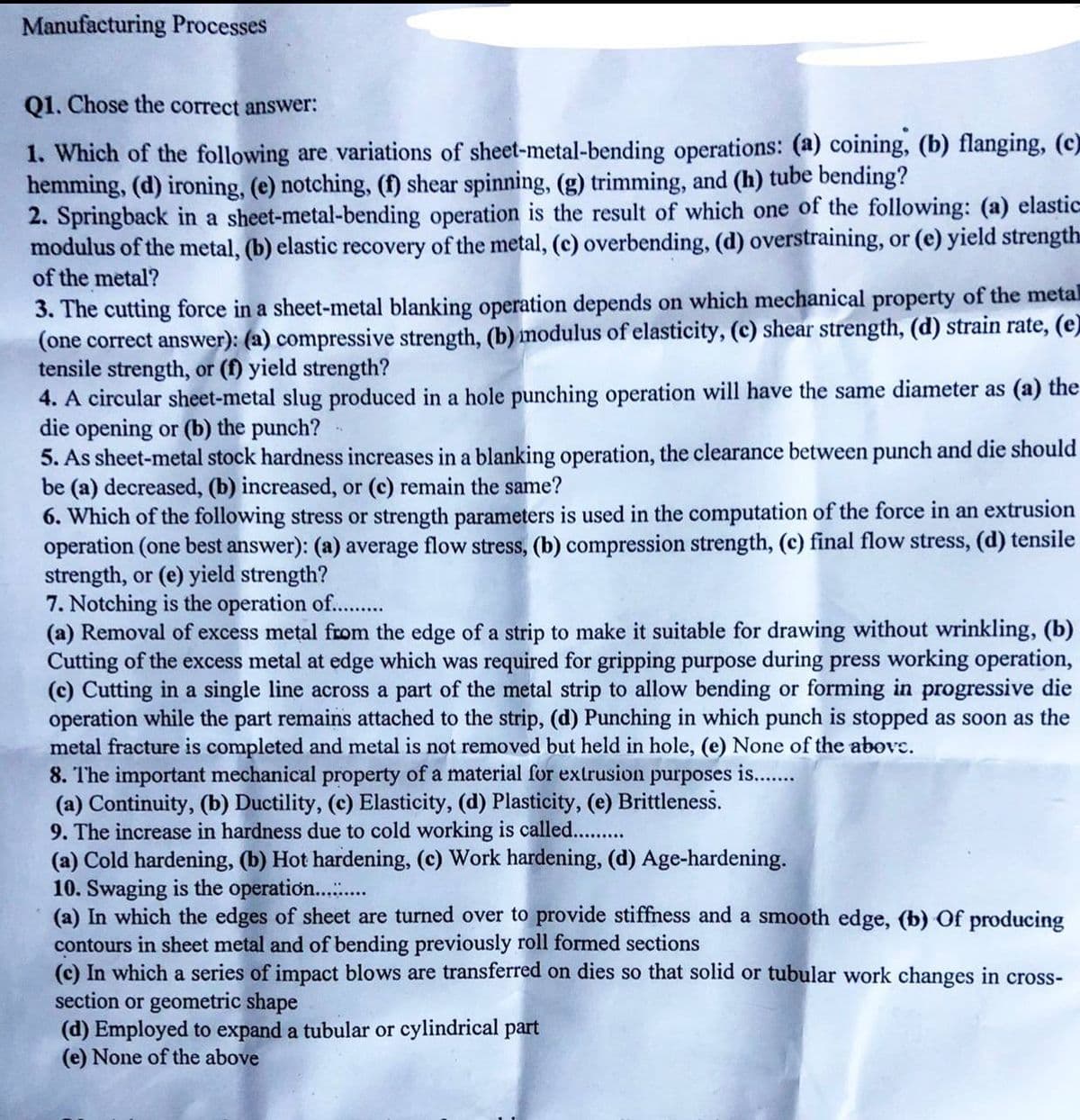Q1. Chose the correct answer: 1. Which of the following are variations of sheet-metal-bending operations: (a) coining, (b) flanging, hemming, (d) ironing, (e) notching, (f) shear spinning, (g) trimming, and (h) tube bending? 2. Springback in a sheet-metal-bending operation is the result of which one of the following: (a) elas modulus of the metal, (b) elastic recovery of the metal, (c) overbending, (d) overstraining, or (e) yield streng of the metal? 3. The cutting force in a sheet-metal blanking operation depends on which mechanical property of the me (one correct answer): (a) compressive strength, (b) modulus of elasticity, (c) shear strength, (d) strain rate, tongilo otrongth or ( vield strength?
Q1. Chose the correct answer: 1. Which of the following are variations of sheet-metal-bending operations: (a) coining, (b) flanging, hemming, (d) ironing, (e) notching, (f) shear spinning, (g) trimming, and (h) tube bending? 2. Springback in a sheet-metal-bending operation is the result of which one of the following: (a) elas modulus of the metal, (b) elastic recovery of the metal, (c) overbending, (d) overstraining, or (e) yield streng of the metal? 3. The cutting force in a sheet-metal blanking operation depends on which mechanical property of the me (one correct answer): (a) compressive strength, (b) modulus of elasticity, (c) shear strength, (d) strain rate, tongilo otrongth or ( vield strength?
Welding: Principles and Applications (MindTap Course List)
8th Edition
ISBN:9781305494695
Author:Larry Jeffus
Publisher:Larry Jeffus
Chapter23: Fabricating Techniques And Practices
Section: Chapter Questions
Problem 11R: What is the difference between plate and sheet material?
Related questions
Question

Transcribed Image Text:Manufacturing Processes
Q1. Chose the correct answer:
1. Which of the following are variations of sheet-metal-bending operations: (a) coining, (b) flanging, (c)
hemming, (d) ironing, (e) notching, (f) shear spinning, (g) trimming, and (h) tube bending?
2. Springback in a sheet-metal-bending operation is the result of which one of the following: (a) elastic
modulus of the metal, (b) elastic recovery of the metal, (c) overbending, (d) overstraining, or (e) yield strength
of the metal?
3. The cutting force in a sheet-metal blanking operation depends on which mechanical property of the metal
(one correct answer): (a) compressive strength, (b) modulus of elasticity, (c) shear strength, (d) strain rate, (e)
tensile strength, or (f) yield strength?
4. A circular sheet-metal slug produced in a hole punching operation will have the same diameter as (a) the
die opening or (b) the punch?
5. As sheet-metal stock hardness increases in a blanking operation, the clearance between punch and die should
be (a) decreased, (b) increased, or (c) remain the same?
6. Which of the following stress or strength parameters is used in the computation of the force in an extrusion
operation (one best answer): (a) average flow stress, (b) compression strength, (c) final flow stress, (d) tensile
strength, or (e) yield strength?
7. Notching is the operation of..........
(a) Removal of excess metal from the edge of a strip to make it suitable for drawing without wrinkling, (b)
Cutting of the excess metal at edge which was required for gripping purpose during press working operation,
(c) Cutting in a single line across a part of the metal strip to allow bending or forming in progressive die
operation while the part remains attached to the strip, (d) Punching in which punch is stopped as soon as the
metal fracture is completed and metal is not removed but held in hole, (e) None of the abovc.
is.......
8. The important mechanical property of a material for extrusion purposes
(a) Continuity, (b) Ductility, (c) Elasticity, (d) Plasticity, (e) Brittleness.
9. The increase in hardness due to cold working is called..........
(a) Cold hardening, (b) Hot hardening, (c) Work hardening, (d) Age-hardening.
10. Swaging is the operation...........
(a) In which the edges of sheet are turned over to provide stiffness and a smooth edge, (b) of producing
contours in sheet metal and of bending previously roll formed sections
(c) In which a series of impact blows are transferred on dies so that solid or tubular work changes in cross-
section or geometric shape
(d) Employed to expand a tubular or cylindrical part
(e) None of the above
Expert Solution
This question has been solved!
Explore an expertly crafted, step-by-step solution for a thorough understanding of key concepts.
Step by step
Solved in 3 steps

Knowledge Booster
Learn more about
Need a deep-dive on the concept behind this application? Look no further. Learn more about this topic, mechanical-engineering and related others by exploring similar questions and additional content below.Recommended textbooks for you

Welding: Principles and Applications (MindTap Cou…
Mechanical Engineering
ISBN:
9781305494695
Author:
Larry Jeffus
Publisher:
Cengage Learning

Welding: Principles and Applications (MindTap Cou…
Mechanical Engineering
ISBN:
9781305494695
Author:
Larry Jeffus
Publisher:
Cengage Learning